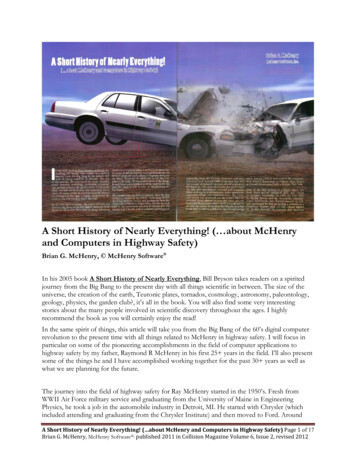
Transcription
A Short History of Nearly Everything! ( about McHenryand Computers in Highway Safety)Brian G. McHenry, McHenry Software In his 2005 book A Short History of Nearly Everything, Bill Bryson takes readers on a spiritedjourney from the Big Bang to the present day with all things scientific in between. The size of theuniverse, the creation of the earth, Teutonic plates, tornados, cosmology, astronomy, paleontology,geology, physics, the garden club?, it’s all in the book. You will also find some very interestingstories about the many people involved in scientific discovery throughout the ages. I highlyrecommend the book as you will certainly enjoy the read!In the same spirit of things, this article will take you from the Big Bang of the 60’s digital computerrevolution to the present time with all things related to McHenry in highway safety. I will focus inparticular on some of the pioneering accomplishments in the field of computer applications tohighway safety by my father, Raymond R McHenry in his first 25 years in the field. I’ll also presentsome of the things he and I have accomplished working together for the past 30 years as well aswhat we are planning for the future.The journey into the field of highway safety for Ray McHenry started in the 1950’s. Fresh fromWWII Air Force military service and graduating from the University of Maine in EngineeringPhysics, he took a job in the automobile industry in Detroit, MI. He started with Chrysler (whichincluded attending and graduating from the Chrysler Institute) and then moved to Ford. AroundA Short History of Nearly Everything! ( about McHenry and Computers in Highway Safety) Page 1 of 17Brian G. McHenry, McHenry Software , published 2011 in Collision Magazine Volume 6, Issue 2, revised 2012
1960 he decided that he’d had enough of research exercises related to product development. Thestraw that broke his spirit’s back was that after spending an extended and successful effort workingon a revolutionary hydro-pneumatic suspension design and implementation, the prototype vehiclewas destroyed and the project filed for potential future interest because the ‘suits’, aka the marketingdepartment, didn’t think it would sell in the existing market. It was then that Ray decided that it wastime to pursue a different type of engineering work. Around 1960 he took a job in the transportationresearch department at Calspan (then known as Cornell Aeronautical Lab) in Buffalo New York.One of the first projects at Calspan which utilized Ray’s unique analytical skills was related tooccupant kinematics. In 1963 the U.S. Public Health Service and the Automobile Manufacturer’sAssociation, Inc. funded research at Calspan performed by Ray to develop a response to aConsumer Reports issue [1] and related reports [2, 3] that included the assertion that American seatbelts failed under the Swedish test conditions and "the major points of failure of the belts testedwere the webbing and the floor brackets themselves".As part of the research Ray McHenry and his team at Calspan created an occupant simulation modelfor longitudinal collisions to assist in the investigation and understanding of the differences betweenUS and European belt standards. The resulting computer program was called the CAL-2D [4]. Theprogram represented one of the first computer simulation applications created and utilized in thefield of highway safety research.Figure 1 CAL-2D Mathematical model of human body and restraint system on test cart(11 degrees of freedom)CAL-2D – Occupant SimulationThe CAL-2D model was created "in order to help improve understanding of the complexrelationships of force-acceleration-time-position-velocity that occur in the impact and energyabsorbing cycle of automobile passenger restraint systems". The study was performed to provideguidance concerning "(1) fundamental differences in the results obtained by static and dynamictesting and (2) the possible need for dynamic acceptance testing of seat belts.A Short History of Nearly Everything! ( about McHenry and Computers in Highway Safety) Page 2 of 17Brian G. McHenry, McHenry Software , published 2011 in Collision Magazine Volume 6, Issue 2, revised 2012
One of the results of the study was the conclusion that "the use of a very short stopping distance ina dynamic cart test of lap belts can produce a distorted comparison of the strength (when belt loadsare not measured) and the performance of webbing materials with different load-elongationcharacteristics. A short ( 3") cart-stopping distance, from 25 mph, used in the European tests,produces increases in the magnitudes of both primary and secondary belt loading cycles over thoseobtained with a more "realistic" ( 17") stopping distance, as encountered in actual automobilecrashes".Subsequent follow-up contracts at Calspan resulted in the creation of a general purpose3-dimensional crash victim simulation program. The development resulted in the creation of theCrash Victim Simulator (CVS) [5]. In the 1980’s, the CVS was adapted for use by the ArmstrongAerospace Medical Research Laboratory at Wright Patterson Air Force Base and was re-named theArticulated Total Body (ATB). The principal investigator of the CVS/ATB development at Calspanwas Dr. John Fleck. [6]. The pioneering work by Dr. Fleck included extremely efficient integrationroutines for economical execution of the program, dynamic memory sharing techniques whichpermitted the program to run with the limited amount of dynamic memory in computers during theera, and the addition of many extensions and refinements to extend and expand simulationcapabilities.Highway Safety ResearchIn 1952, a pioneer program in highway safety research, the Automobile Crash Injury ResearchProgram (ACIR), was created by Cornell University with the objective of determining injurycausation among occupants of cars involved in accidents, in order that the injuries might beprevented or mitigated through improved vehicle design. By the mid sixties, 31 states hadparticipated in the program and provided over 50000 cases for study [7]. The main criterion forclassifying severity in the ACIR program was through the use of comparison photographs ofdamaged vehicles.In 1966 the National Traffic & Motor Vehicle Safety Act (P.L. 89-563, 80 Stat. 718) was passedwhich established the Federal Motor Vehicle Safety Standards (FMVSS) and the National TrafficSafety Agency (now known as NHTSA). The Motor Safety Act required regulators to establishfederal motor vehicle safety standards to protect the public against "unreasonable risk of accidentsoccurring as a result of the design, construction or performance of motor vehicles" and also against"unreasonable risk of death or injury . in the event accidents do occur."At the time of signing the Safety Act into law President Johnson stated “Auto accidents are thebiggest cause of death and injury among Americans under the age of 35”. In 1965, 50,000 peoplewere killed on our nation’s highways. Since 1966, the Department of Transportation (DOT) hastaken a comprehensive approach to reducing roadway fatalities by promoting strong traffic safetylaws coupled with high-visibility enforcement and through rigorous vehicle safety programs andpublic awareness campaigns.The success of the traffic safety program was demonstrated in year 2010 when NHTSA reported that the numberand rate of traffic fatalities in 2010 fell to the lowest levels since 1949, despite a significant increase in the numberof miles Americans drove during the year. Since 2005, fatalities have dropped 25 percent, from a total of 43,510fatalities in 2005 to 32,788 in 2010. The fatality rate will be the lowest recorded since 1949, with 1.09 fatalitiesper 100 million vehicle miles traveled, down from the 1.13 fatality rate for 2009. The decrease in fatalities for2010 occurred despite an estimated increase of nearly 21 billion miles in national vehicle miles traveled.A Short History of Nearly Everything! ( about McHenry and Computers in Highway Safety) Page 3 of 17Brian G. McHenry, McHenry Software , published 2011 in Collision Magazine Volume 6, Issue 2, revised 2012
Figure 2 Highway Accident Fatality Rate from 1966 to 2005Also during the 60's, the digital computer came of age. Mainframe computers, which filled entirefloors of buildings, and cost hundreds of thousands to millions of dollars evolved into time-sharing,batch processing machines.Before the introduction of the microprocessor in the early 1970s, computers were large multi-million dollar systems(like the IBM/360) which consumed entire floors of buildings, required their own cooling systems, and were ownedby institutions like corporations, universities and government agencies. Computer users normally used punchedcards to enter tasks into the computer and individual computational ‘jobs’ on the computer were entered in ‘batchmode’ and controlled by Job Control Language (JCL). Output from the computers was generally printed output.These were used in conjunction with 9-track tapes (for storage), card punch and reader machines (for creating andreading program input) and terminals to provide to scientists, engineers and others number crunching capabilitiesunlike any utility ever before imagined.The costs of operating large scientific mainframe computers were dropping significantly in the early sixties. Aprogram which cost 100 to run in 1962 cost only approximately 5.65 in 1966 [8]. Other items which we takefor granted today are processing speed and disk capacity. A measure of computation power is FLoating pointOperations Per Seconds (FLOPS). In the mid 1960s FLOPS were at a rate of approximately 1 million, alsoknown as a megaFLOP. In 2010, FLOPS were approaching petaFLOPS (1016). Also disk and memorycapacities were extremely limited on these computers. We have extraordinary processing capacity and power at ourfingertips today with our notebook computers operating at petaFLOPS and containing gigabytes of memory andterabytes of disk capacities. The age of the notebook supercomputer is upon us now!A Short History of Nearly Everything! ( about McHenry and Computers in Highway Safety) Page 4 of 17Brian G. McHenry, McHenry Software , published 2011 in Collision Magazine Volume 6, Issue 2, revised 2012
Figure 3 HVOSM analytical representation of vehicleHVOSM: The Highway Vehicle Object Simulation ModelReturning to the mid-60's the Calspan Corporation began development of a general mathematicalmodel and computer simulation of the dynamic responses of automobiles under the direction of RayMcHenry [9]. The mathematical model, which was subsequently named the Highway Vehicle ObjectSimulation Model (HVOSM), included the general three-dimensional motions resulting from vehiclecontrol inputs, traversals of terrain irregularities and collisions with certain types of roadsideobstacles.The development of the HVOSM included an extensive validation effort within which a series ofrepeated full-scale tests with instrumented vehicles was performed to permit an objective assessmentof the degree of validity of the computer model [10].The need for analytical capabilities in highway safety research becomes apparent when one considersthe large number of variables that influence both the occurrence and the consequences of highwayaccidents. Actual accidents include an infinite variety of combinations of direction, speed, evasivemaneuvers, obstacles, vehicle and terrain properties, vehicle occupancy and conditions of occupantrestraint, Therefore to perform a rigorous evaluation of the benefits to be achieved by a givenchange in vehicle or roadside design one must include consideration of a representative sample ofvehicles, operating conditions, occupancy and occupant restraints.In a full-scale experimental evaluation, the generally poor repeatability (i.e.,, the scatter in results)makes it necessary to include several runs of each test condition. Obviously, a purely experimentalevaluation procedure is both time consuming and expensive. Experiments also do not provide acapability of predicting responses of a complex, nonlinear system. Validated analytical procedurescan serve to reduce the required number of full scale tests by providing a means of interpolating andextrapolating experimental results for widely spaced test conditions. They can also serve to provide apredictive capability and, thereby, a theoretical framework within which tests can be planned andexperimental data interpreted. The highly nonlinear nature of the physical system, both in violentA Short History of Nearly Everything! ( about McHenry and Computers in Highway Safety) Page 5 of 17Brian G. McHenry, McHenry Software , published 2011 in Collision Magazine Volume 6, Issue 2, revised 2012
evasive maneuvers and in collisions, demands that realistic analytical procedures be programmed forcomputer solution.At the time of the development of the HVOSM, an extensive body of literature existed on analyticalstudies of automobile dynamics, but the general approach at the time involved separate treatment ofmotions in the longitudinal plane (ride responses, performance and braking) and motions in thelateral plane (cornering behavior and stability). Furthermore, the equations of motion had generallybeen linearized. While such practices are acceptable in studies of small disturbance handlingqualities, they are not appropriate for violent maneuvers at the upper limits of vehicle control. Inview of the extended requirements for a realistic analysis of vehicle dynamics in near-accident andaccident situations, where interactions between ride and cornering motions cannot be neglected, thenonlinear HVOSM computer simulation of automobile dynamics was developed to permit the studyof simultaneous, large amplitude ride and cornering motions and to include an approximatetreatment of collision forces.The HVOSM vehicle representation has fifteen degrees of freedom: 6 for the sprung-mass, and upto 9 for the unsprung-masses. Tire side forces are generated according to equations allowing forsaturation to occur at large slip angles. The “friction circle” and the "friction ellipse" concepts areused to simulate the effects of braking and traction on the side forces. The simulated suspensionforces include progressively stiffening, energy dissipating limit stops and a combination of coulomband viscous damping. The sprung mass is represented as a rigid body with a peripheral layer ofhomogeneous, isotropic, deformable material. The assumed properties of the peripheral layer, withdynamic pressure directly proportional to depth of penetration, were based on the results ofdynamic and static crush tests of automobile structures,Some researchers in the field of highway safety have a tendency to view experiments, whether partor full scale, as being more real and believable than analyses. At least part of this tendency stemsfrom the fact that physical experiments can be seen and photographed. Computer graphics displayscan help in analysis by allowing the direct observation of computer "experiments", In actuality, manyphysical experiments are poorly defined and controlled. Instrumentation errors sometimes yieldindividual items of response that are not compatible with each other. For example, in the series ofphysical experiments that were performed to validate the HVOSM, a number of instrumentationdifficulties were revealed by the comparisons with analytically predicted results. It is not intended tosuggest that computer simulation can ever eliminate the need for physical experiments; Rather, theintention is merely to point out the fact that computer simulations can serve as valuable aids forinterpreting the results of physical experiments with nonlinear systems, as well as for interpolationand extrapolation to other combinations of test conditions.In 1969 the paper by Raymond R McHenry on the HVOSM development entitled "An Analysis of theDynamics of Automobiles During Simultaneous Cornering and Ride Motions", [11] was awarded theCrompton-Lanchester Medal from the Institution of Mechanical Engineers. Awarded by the Board of theAutomobile Division for the best paper or for outstanding service considered to have special influence on theadvancement of automobile engineering.A Short History of Nearly Everything! ( about McHenry and Computers in Highway Safety) Page 6 of 17Brian G. McHenry, McHenry Software , published 2011 in Collision Magazine Volume 6, Issue 2, revised 2012
Figure 4The first live performance of the astro spiral jump in Houston, TX 1972The Astro-Spiral JumpIn addition to the substantial effort in validation of the mathematical model, the HVOSM was alsouniquely tested by designing an automobile stunt which was used both in a travelling auto-stunt thrillshow and in the 1974 James Bond Movie, “Man with the Golden Gun” produced by United ArtistsCorporation [12].As a part of the HVOSM development process, Calspan employed the services of professional stuntdrivers in 1968 to perform maneuvers and stunts with an instrumented vehicle and, thereby, togenerate vehicle response data in violent maneuvers for use in investigating the validity of thecomputer simulation. One of the included stunts was a fifty foot jump from a take-off to a receivingramp. The degree of achieved correlation between analytical predictions and experimentalmeasurements was found to be remarkably good in all of the included maneuvers and stunts. At thetime, it was jokingly pointed out that Calspan had unintentionally developed a capability for thedesign and staging (i.e., via animated perspective displays on motion picture film) of auto thrillshows. A related, "far out" suggestion was the design of ramps to produce a combination of jumpand rollover (i.e., a "spiral" jump), such that the stunt car would land on its wheels after passing overan obstacle in an inverted condition.Subsequent to completion of development and validation of the HVOSM simulation in 1970, thethrill show ideas were given somewhat more serious consideration. Such an application wouldconstitute both a challenging dynamics problem, similar in nature to a particularly violent singlevehicle accident, and an attention-getting demonstration of capabilities. It also had the appeal of a"fun" project to relieve a steady diet of crash protection studies.In November of 1970 Ray McHenry contacted Jay Milligan, Jr., President, J.M, Productions, Inc., ofHamburg, New York, regarding his possible interest in the design of a new auto thrill show stuntand/or the establishment of speed and dimensional tolerances for existing stunts.A Short History of Nearly Everything! ( about McHenry and Computers in Highway Safety) Page 7 of 17Brian G. McHenry, McHenry Software , published 2011 in Collision Magazine Volume 6, Issue 2, revised 2012
Figure 5 Comparison of test driver ramp to ramp jump and HVOSM simulation predictionsThe HVOSM simulation does not, of course, provide direct guidance for invention. Its application isequivalent to performing experiments with a fully instrumented-vehicle. Therefore, the analyticalstudy of the spiral jump stunt concept consisted essentially of a trial and error process of exploratorychanges in ramp configurations. The initial simulation study indicated that the combined needs torun both ends of the automobile over the same ramp profile in sequence and to generate a large rollacceleration in the 40 MPH speed range would create a serious problem in achieving acceptablepitch and yaw behavior. The limitation to the speed range of 40 MPH, which is based on spacerestrictions that generally exist for thrill show performances, produced a corresponding limitation onthe time in the air that was available for the 360 degree roll- over. Thus, a large roll velocity(approximately 230 degrees per second) had to be generated to achieve a "wheels down" landing onthe receiving ramp. The sequential traversal of the take-off ramp by the front and the rear wheels,when combined with the nonlinear suspension characteristics during the traversal (i,e., frontA Short History of Nearly Everything! ( about McHenry and Computers in Highway Safety) Page 8 of 17Brian G. McHenry, McHenry Software , published 2011 in Collision Magazine Volume 6, Issue 2, revised 2012
suspension "bottomed out" throughout the roll impulse) was found to create a response sequence inwhich the rear wheels cleared or only lightly touched the "roll-impulse" end of the ramp.As a result of this sequence, the initially predicted responses retained a "nose-up" attitude during theentire jump and were found to include excessive yawing. Attempts to achieve a corrective pitchimpulse at either of the rear wheels were unsuccessful, The rear wheel that was moving up fastestcleared any ramp configuration that the "bottomed out" front suspension had traversed, An impulsesufficient for the desired pitch response, when applied at the other rear wheel, acted to excessivelyreduce the roll velocity. Therefore, it became necessary to consider minor vehicle modifications toachieve the desired combination of linear and angular velocities at the end of the take off ramp. Thenecessary vehicle modification consisted of an auxiliary contact point on the rear axle, for which theprimary loading occurred on the last ten feet of the take-off ramp. The additional contact on the rearaxle was also found to require a relatively low side-force capability to avoid unwanted yawaccelerations.In the 60’s and 70’s Ray worked with Bill Milliken[13] at Calspan. Ray has always said that withoutBill’s perseverance and influence the spiral jump project would have never been completed. Bill fought for theproject and fought off the Calspan management who were paranoid about liability. Bill was somehow able toarrange to have the original AMC Javelin vehicle measured at the GM Proving Grounds in Michigan. Yes,that is correct; somehow Bill was able to arrange to have an AMC vehicle measured at the GM facility.Talk about pull! Ray, my brother Stan McHenry and Doug Milliken (Bill’s son) all drove from Buffalo toMichigan and on to the GM proving grounds with the AMC Javelin to have the measurements done!The first live performance of the “spiral jump” stunt was performed at the Houston Astrodome in 1972before a sellout crowd of more than 100,000. For the actual ‘traveling stunt’ the target speeds, weight anddistance were 40 /- 1MPH and 1461 /- 3 kg, and 13.85 /- 0.03 m. A thrill show toured with thestunt both before and after James Bond picked it up for the movie. For many of the tour shows in the US, thedrivers came in slow (below the low speed) and damaged the suspension and landing ramp on landing.Bumps Willard, who performed the stunt flawlessly (one take!) for the Bond movie also toured Europe withthe thrill show and hit the jump perfectly every time!In 1976, after 10 years of development, refinement and applications of the HVOSM by Calspan aswell as other research organizations, under FHWA contract Calspan documented all the variousdevelopments, refinements and validations of the HVOSM [14].Since 1976 Ray and I have performed a number research projects which included furtherrefinements and enhancements of the HVOSM under subcontracts with Jack Leisch and Associates[15], Midwest Research Institute [16], Calspan [17] and the Highway Safety Research Center of theUniversity of North Carolina [18] as well as through internal research[19].A Short History of Nearly Everything! ( about McHenry and Computers in Highway Safety) Page 9 of 17Brian G. McHenry, McHenry Software , published 2011 in Collision Magazine Volume 6, Issue 2, revised 2012
Figure 6Spiral Jump driver’s view to takeoff and landing rampsSMAC – The Simulation Model of Automobile CollisionsAround 1970 the SMAC computer program was created by Ray and his team at Calspan on year-endfunds. Year-end funds are left over research money which needs to be used before the end of theyear (‘use it or lose it’). Ray was interested in demonstrating the feasibility of a mathematical modelof automobile collisions which could achieve improved uniformity and accuracy in the interpretationof evidence in automobile accidents.Prior to the creation of SMAC, the general practice in the reconstruction of automobile collisionswas to consider the collision and the trajectory phases of the event separately. This division of theanalytical task was based on two assumptions: (1) that the effects of tire forces are negligible duringthe existence of collision forces and (2) that the collision event can be assumed to occurinstantaneously.While these assumptions appear to be reasonable, their application had been found in some impactconfigurations to produce significant errors during the collision. For example, in moderate-speedintersection collisions multiple contacts frequently occur – front-side followed by side-to-side and orrear-to-side contact, normally referred to as a “side-slap” secondary contact [20]. If a secondarycontact is neglected in a collision reconstruction major errors can be produced in predictions ofspin-out trajectories. Also, if tire forces are neglected throughout the time during which the collisioncontacts occur, significant errors can be introduced during the lateral motions of the vehicle betweenimpacts. Therefore the SMAC program was created with provisions that both the collision and tireforces be considered simultaneously.SMAC is an "open-form" accident reconstruction program. A requirement of "open-form"programs like SMAC is that the user must initially estimate the impact speeds.A Short History of Nearly Everything! ( about McHenry and Computers in Highway Safety)Page 10 of 17Brian G. McHenry, McHenry Software , published 2011 in Collision Magazine Volume 6, Issue 2, revised 2012
One of the difficulties which arose in setting up SMAC simulations by the NHTSA investigativeteams was that the program requirement of an initial estimate of the impact speeds which was notalways an easy task. Also, the user had to provide vehicle properties and specifications, many ofwhich were not readily available. Those requirements, combined with the relatively high cost per runfor a SMAC simulation run, required that a pre-processor be created which could provide the initialestimate of the impact speeds.The CRASH computer program [21] was created to assist SMAC users in determining a firstestimate of impact speeds. So let us digress for a moment to discuss CRASH:CRASH - Computerized Reconstruction of Accident Speeds on the HighwayThe original CRASH program utilized both piecewise-linear trajectory solution procedures and adamage analysis procedure to provide an initial estimate of impact speeds. The CRASH programwas subsequently adopted by NHTSA as an integral part of the NASS investigations.The National Accident Sampling System (NASS) was established in 1979 as part of a nationwide effort toreduce motor vehicle crashes, injuries and deaths on the US highways. The NASS General Estimate System(GES) collects data for nonfatal crashes, and combines that data with information on fatal crashes from theFatal Analysis Reporting System (FARS).Data for GES come from a nationally representative sample of police reported motor vehicle crashes of all types,from minor to fatal. The system was created to identify traffic safety problem areas, provide a basis for regulatoryand consumer initiatives, and form the basis for cost and benefit analyses of traffic safety initiatives. Theinformation is used to estimate how many motor vehicle crashes of different kinds take place, and what happenswhen they occur. GES data are used in traffic safety analyses by NHTSA as well as other DOT agencies.GES data are also used to answer motor vehicle safety questions from Congress, lawyers, doctors, students,researchers, and the general public.The rationale for the use of the CRASH program was that for statistical studies, the average error inseverity determinations is more important than specific individual errors. The CRASH program,with it's question and answer mode, vehicle categorization, single step solution procedure, and mostimportantly low cost, redirected the NHTSA interest from SMAC towards the CRASH computerprogram.The original form of the CRASH computer program, which culminated in the CRASH3 version,was not intended to be a detailed, highly accurate reconstruction program. Rather, it was developedto serve as a simple preprocessor for the SMAC program. While the results of CRASH3applications can be useful in providing approximate measures of accident severity for use instatistical studies, where the average error is most important, it has been demonstrated in validationtests to produce results which when compared to those of full-scale crash tests can includeindividual errors as great as 45%[22].Obviously any CRASH results utilized in individual case reconstructions, like for police and/orlitigation purposes, need to be further tested and refined with more sophisticated accidentreconstruction techniques.A Short History of Nearly Everything! ( about McHenry and Computers in Highway Safety)Page 11 of 17Brian G. McHenry, McHenry Software , published 2011 in Collision Magazine Volume 6, Issue 2, revised 2012
The first project I worked on in the field of Highway safety was in 1979 and was related to arefinement of CRASH3 under contract with NHTSA [23]. My part of the contract was evaluatingthe results of a large number of SMAC simulations of various accident types to be used to refineSPIN2 of the CRASH3 trajectory solutions procedure.To improve the accuracy of approximations of separation velocities, provisions for the introductionof a residual linear velocity at the end of the rotational motion and the development of empiricalcoefficients, in the form of polynomial functions of the ratio of linear to angular velocity atseparation, were incorporated in the SPIN2 analytical relationships of the CRASH program. Sincethe separation velocity
A Short History of Nearly Everything! ( about McHenry and Computers in Highway Safety) Page 3 of 17 Brian G. McHenry, McHenry Software , published 2011 in Collision Magazine Volume 6, Issue 2, revised 2012 One of the results of the study was the conclusion that "the use of a very short stopping distance in










